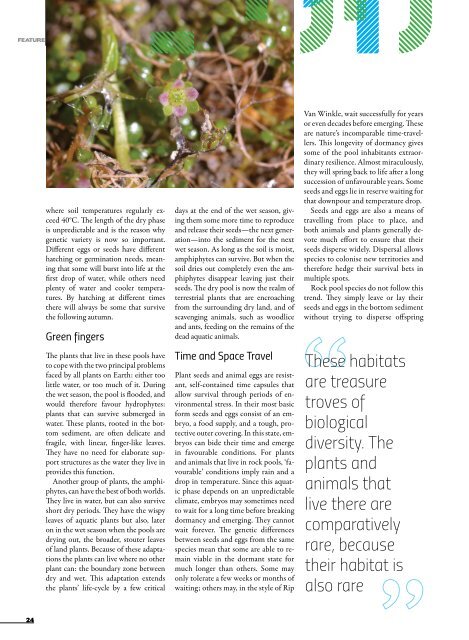Create successful ePaper yourself
Turn your PDF publications into a flip-book with our unique Google optimized e-Paper software.
Feature<br />
pool Bio<br />
where soil temperatures regularly exceed<br />
40°C. The length of the dry phase<br />
is unpredictable and is the reason why<br />
genetic variety is now so important.<br />
Different eggs or seeds have different<br />
hatching or germination needs, meaning<br />
that some will burst into life at the<br />
first drop of water, while others need<br />
plenty of water and cooler temperatures.<br />
By hatching at different times<br />
there will always be some that survive<br />
the following autumn.<br />
Green fingers<br />
The plants that live in these pools have<br />
to cope with the two principal problems<br />
faced by all plants on Earth: either too<br />
little water, or too much of it. During<br />
the wet season, the pool is flooded, and<br />
would therefore favour hydrophytes:<br />
plants that can survive submerged in<br />
water. These plants, rooted in the bottom<br />
sediment, are often delicate and<br />
fragile, with linear, finger-like leaves.<br />
They have no need for elaborate support<br />
structures as the water they live in<br />
provides this function.<br />
Another group of plants, the amphiphytes,<br />
can have the best of both worlds.<br />
They live in water, but can also survive<br />
short dry periods. They have the wispy<br />
leaves of aquatic plants but also, later<br />
on in the wet season when the pools are<br />
drying out, the broader, stouter leaves<br />
of land plants. Because of these adaptations<br />
the plants can live where no other<br />
plant can: the boundary zone between<br />
dry and wet. This adaptation extends<br />
the plants’ life-cycle by a few critical<br />
days at the end of the wet season, giving<br />
them some more time to reproduce<br />
and release their seeds—the next generation—into<br />
the sediment for the next<br />
wet season. As long as the soil is moist,<br />
amphiphytes can survive. But when the<br />
soil dries out completely even the amphiphytes<br />
disappear leaving just their<br />
seeds. The dry pool is now the realm of<br />
terrestrial plants that are encroaching<br />
from the surrounding dry land, and of<br />
scavenging animals, such as woodlice<br />
and ants, feeding on the remains of the<br />
dead aquatic animals.<br />
Time and Space Travel<br />
Plant seeds and animal eggs are resistant,<br />
self-contained time capsules that<br />
allow survival through periods of environmental<br />
stress. In their most basic<br />
form seeds and eggs consist of an embryo,<br />
a food supply, and a tough, protective<br />
outer covering. In this state, embryos<br />
can bide their time and emerge<br />
in favourable conditions. For plants<br />
and animals that live in rock pools, ‘favourable’<br />
conditions imply rain and a<br />
drop in temperature. Since this aquatic<br />
phase depends on an unpredictable<br />
climate, embryos may sometimes need<br />
to wait for a long time before breaking<br />
dormancy and emerging. They cannot<br />
wait forever. The genetic differences<br />
between seeds and eggs from the same<br />
species mean that some are able to remain<br />
viable in the dormant state for<br />
much longer than others. Some may<br />
only tolerate a few weeks or months of<br />
waiting; others may, in the style of Rip<br />
Van Winkle, wait successfully for years<br />
or even decades before emerging. These<br />
are nature’s incomparable time-travellers.<br />
This longevity of dormancy gives<br />
some of the pool inhabitants extraordinary<br />
resilience. Almost miraculously,<br />
they will spring back to life after a long<br />
succession of unfavourable years. Some<br />
seeds and eggs lie in reserve waiting for<br />
that downpour and temperature drop.<br />
Seeds and eggs are also a means of<br />
travelling from place to place, and<br />
both animals and plants generally devote<br />
much effort to ensure that their<br />
seeds disperse widely. Dispersal allows<br />
species to colonise new territories and<br />
therefore hedge their survival bets in<br />
multiple spots.<br />
Rock pool species do not follow this<br />
trend. They simply leave or lay their<br />
seeds and eggs in the bottom sediment<br />
without trying to disperse offspring<br />
These habitats<br />
are treasure<br />
troves of<br />
biological<br />
diversity. The<br />
plants and<br />
animals that<br />
live there are<br />
comparatively<br />
rare, because<br />
their habitat is<br />
also rare<br />
24


